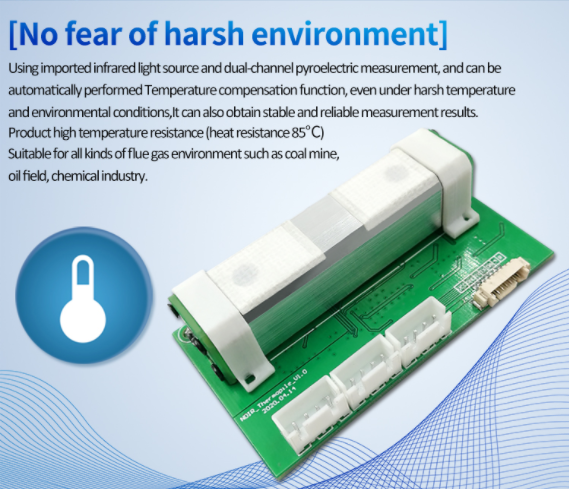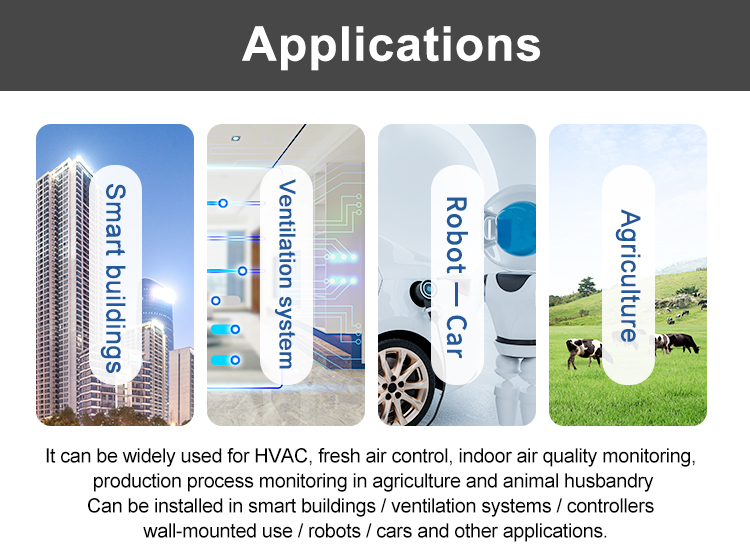Introduction to NDIR CO2 Sensors
Non-dispersive infrared (NDIR) CO2 sensor are advanced devices designed to measure carbon dioxide (CO2) levels in various environments. These sensors utilize the principle of infrared light absorption to accurately detect and quantify the concentration of CO2 gas. NDIR CO2 sensors have found widespread applications in indoor air quality monitoring, HVAC systems, industrial safety, and environmental research due to their precision, reliability, and versatility.
This article aims to provide a comprehensive overview of NDIR CO2 sensors, including their working principles, technology advancements, calibration methods, and diverse applications across different industries. By understanding the underlying technology and practical uses of NDIR CO2 sensors, readers can gain valuable insights into the importance of monitoring CO2 levels and the role of these sensors in ensuring health, safety, and environmental sustainability.
Working Principles of NDIR CO2 Sensors

The working principles of NDIR CO2 sensors are rooted in the fundamental properties of infrared light and the interaction between CO2 molecules and specific wavelengths of infrared radiation. The key components of an NDIR CO2 sensor typically include an infrared light source, a gas chamber containing the sample gas, and a detector capable of measuring the intensity of infrared light after it passes through the gas sample.
The operation of an NDIR CO2 sensor can be summarized as follows:
- Infrared Light Source: The sensor emits infrared light at specific wavelengths that are selectively absorbed by CO2 molecules. The light source is designed to produce a stable and precise output of infrared radiation.
- Gas Chamber: The gas chamber contains the sample gas, which may be ambient air or a controlled environment where CO2 levels need to be monitored. As the infrared light passes through the gas, CO2 molecules absorb specific wavelengths of the light, leading to a reduction in the intensity of the transmitted light.
- Detector: A highly sensitive detector measures the intensity of the infrared light that has passed through the gas sample. The reduction in light intensity is directly proportional to the concentration of CO2 in the gas sample.
- Signal Processing: The output from the detector is processed to calculate the CO2 concentration based on the observed reduction in infrared light intensity. This processed signal provides a real-time measurement of CO2 levels in the monitored environment.
Technology Advancements in NDIR CO2 Sensors
In recent years, significant advancements have been made in the design and performance of NDIR CO2 sensor, driven by the demand for more accurate, reliable, and cost-effective solutions for CO2 monitoring. Some of the notable technology advancements in NDIR CO2 sensors include:

Dual-Wavelength Detection: Modern NDIR CO2 sensors may incorporate dual-wavelength detection techniques to enhance accuracy and minimize the impact of interfering gases. By utilizing two distinct infrared wavelengths, these sensors can differentiate between CO2 absorption and potential interferences, resulting in more precise measurements.
Advanced Signal Processing: Improved signal processing algorithms and digital signal processing (DSP) capabilities have enabled NDIR CO2 sensors to provide enhanced stability, response time, and immunity to environmental variations. These advancements contribute to the overall performance and reliability of the sensors in dynamic operating conditions.
Miniaturization and Integration: NDIR CO2 sensors have undergone miniaturization, allowing for compact and integrated designs suitable for portable devices, IoT applications, and embedded systems. The smaller form factor and integration with microcontrollers or communication interfaces have expanded the deployment possibilities for NDIR CO2 sensors.
Low Power Consumption: Energy-efficient designs and low-power consumption have become essential features of modern NDIR CO2 sensors, enabling prolonged operation on battery-powered devices and reducing the overall environmental impact of sensor deployment.
Calibration and Accuracy of NDIR CO2 Sensors
Calibration is a critical aspect of ensuring the accuracy and reliability of NDIR CO2 sensors. Proper calibration procedures are essential to account for sensor drift, environmental changes, and aging effects that may impact the sensor’s performance over time. Calibration of NDIR CO2 sensors typically involves the following steps:
- Factory Calibration: Manufacturers perform initial calibration and characterization of NDIR CO2 sensors to establish baseline performance characteristics. This includes setting reference points for CO2 concentration measurements and validating the sensor’s accuracy under controlled conditions.
- Field Calibration: In real-world applications, NDIR CO2 sensors may require periodic field calibration to account for environmental factors, sensor aging, and long-term drift. Field calibration involves adjusting the sensor’s output based on known reference standards or calibration gases to maintain accurate measurements.
- Multi-Point Calibration: Some NDIR CO2 sensors support multi-point calibration, where the sensor’s response is calibrated at multiple CO2 concentration levels to create a more comprehensive calibration curve. Multi-point calibration enhances the sensor’s accuracy across a wider range of CO2 concentrations.
- Automatic Calibration Features: Advanced NDIR CO2 sensors may include automatic calibration features that enable self-correction based on internal reference measurements or external calibration signals. These features contribute to long-term stability and reduce the need for frequent manual calibration.
Applications of NDIR CO2 Sensors
NDIR CO2 sensors have diverse applications across various industries and environments, where the accurate monitoring of CO2 levels is essential for maintaining air quality, ensuring safety, and optimizing operational processes. Some common applications of NDIR CO2 sensors include:

Indoor Air Quality Monitoring: NDIR CO2 sensors are widely used in commercial buildings, schools, hospitals, and residential spaces to monitor indoor air quality and ensure proper ventilation. By measuring CO2 levels, these sensors help optimize HVAC systems and support occupant health and comfort.
HVAC Systems and Energy Management: NDIR CO2 sensors play a crucial role in demand-controlled ventilation systems and energy management solutions by providing real-time feedback on indoor CO2 concentrations. This information enables energy-efficient operation of HVAC systems based on actual occupancy and air quality conditions.
Industrial Safety and Emissions Monitoring: In industrial settings, NDIR CO2 sensors are employed for monitoring workplace air quality, detecting leaks of CO2 gas, and ensuring compliance with safety regulations. Additionally, these sensors are utilized for emissions monitoring in industrial processes and environmental compliance reporting.
Environmental Research and Climate Studies: NDIR CO2 sensors are utilized in environmental research and climate studies to measure atmospheric CO2 levels, track carbon cycle dynamics, and contribute to the understanding of global carbon emissions and climate change impacts.
Agriculture and Greenhouse Gas Monitoring: In agricultural applications and greenhouse environments, NDIR CO2 sensors are used to optimize plant growth conditions, monitor CO2 enrichment, and assess the impact of agricultural activities on CO2 emissions and sequestration.
Automotive and Transportation: NDIR CO2 sensors are integrated into automotive air quality monitoring systems to measure CO2 levels inside vehicles and support advanced driver-assistance systems (ADAS) for optimizing cabin air quality.
Conclusion
NDIR CO2 sensors represent a critical technology for monitoring carbon dioxide levels in diverse settings, ranging from indoor environments to industrial facilities and environmental research. The precise measurement capabilities, technological advancements, and wide-ranging applications of NDIR CO2 sensors underscore their importance in ensuring air quality, safety, and environmental sustainability.
As the demand for accurate CO2 monitoring continues to grow, ongoing research and development efforts are focused on further enhancing the performance, reliability, and integration capabilities of NDIR CO2 sensors. By leveraging the insights provided in this article, stakeholders across industries can gain a deeper understanding of NDIR CO2 sensor technology and its pivotal role in addressing the challenges associated with CO2 monitoring and management.